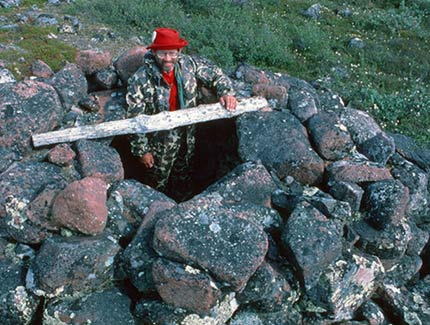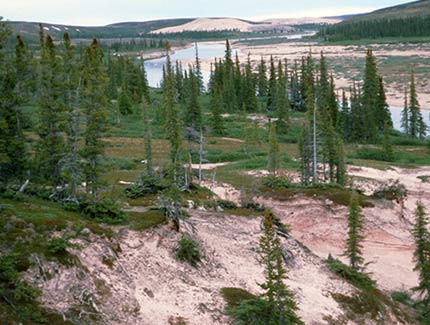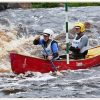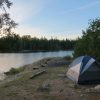Clarke and Thelon Rivers Summary

Nunavut, Canada
June 29 — July 28, 1990
Route:
The four of us drove in a van from the Minneapolis/St. Paul area to Points North Landing, near Wollaston Lake in northern Saskatchewan. We drove continuously for 27 1/2 hours over two days, including brief stops for meals, gas, and other incidentals. Upon arrival, Points North provided a bunkhouse for us and breakfast the next morning.
Then we flew in a single-engine Otter approximately 400 miles north to a small lake at the headwaters of the Clarke River in what is now Nunavut where we unloaded on a sandy beach. From there we spent most of 9 days on the Clarke River and 17 days on the Thelon River ending near Hoare Point on Beverly Lake where we were picked up by a float plane from Points North Landing. We did not travel on the day we flew in or the day we flew out and we took four layover days. On the 20 days that we paddled downriver, we covered about 253 miles, averaging 12.7 miles per day of travel.

River Conditions:
This was a fairly leisurely trip with no portages and plenty of time for hiking and fishing. The Clarke River averaged 75 to 100 feet wide. It had swift water, numerous Class I riffles, and a few Class II rapids. We lined one rapid, but ran all the others. The Clarke River gets very shallow and rocky soon after the snow melts, so canoeists are advised to paddle this river early in the season.
The Thelon River averaged nearly ¼ mile wide and had swift current. There was only one significant rapid, just below the confluence with the Clarke River, but we ran that rapid near the left bank. There were some big standing waves near the Thelon Bluffs, but we bypassed those by remaining on the right side of the river.
Campsites:
Good campsites were relatively easy to find on sandy banks or short tundra vegetation. We passed a half dozen other canoe parties on the Thelon River, but camped only once near another party.
Archeological Sites:
Along the Clarke River we saw a few Inuit tent rings and a hunting blind. Just below the confluence with the Hanbury River, we missed seeing the Warden’s Cabin built to house the original Wardens who protected the Thelon Wildlife Sanctuary from poachers. At Hornby Point we found the remains of the Hornby cabin and the graves of John Hornby, Edgar Christian, and Harold Adlard who had died from starvation. All of us had read Edgar Christian’s journal before the trip. Along the Thelon we periodically found Inuksuit, hunting blinds, tent rings, meat caches, fox traps, and rock-on-rock markers. We also found a flint scraping tool, broken spear points, scraps of wood, and a portion of a muskox horn in an old Inuit campsite. These artifacts became more common as we moved downstream, especially below the Thelon Bluffs and beyond.

Topography:
The Clarke River ran through a valley with hills about 75 feet high bordering the river. Side canyons also had steep sides and were interesting to explore by hiking. Near the end of the Clarke, we encountered an 8-mile stretch of river flowing through a rocky canyon with 30- to 40-foot high walls. The Clarke also had some sandy banks and a few large sand dunes. It was quite a scenic river.
The Thelon was a broad river bordered by hills rising 75 to 200 feet high. There periodically were steep banks of clay or rock that added interest. We found a picturesque 20-foot-high waterfall on a small tributary stream about 35 miles down the Thelon on the right shoreline. It was not visible from the river, but we happened to stop for lunch and found it while hiking up the stream valley. We also enjoyed hiking inland to see Muskox Hill, a pingo. This pingo is about 60 feet high with some eroded earthen spires at the top. Pingos form in low, wet areas that freeze deeply. They have a core of ice. It was located about 54 miles down the Thelon River. In general, though, there were few topographic and geologic features of interest along the Thelon.
Vegetation:
Tundra vegetation predominated on the entire trip, but there were clumps of spruce trees along the Clarke River, particularly on lower river slopes and in ravines. Willow shrubs were common near river banks, but did not impede travel or camping.

Insects, Fish, & Wildlife:
Mosquitoes and black flies were missing for the first few days of our trip, but once temperatures began rising to the 70s, they hatched and were a major nuisance for the remainder of the trip. Canoeists are advised to take a bug tent for shelter while cooking and lounging.
The Clarke River provided excellent grayling fishing as well as a few lake trout up to 5 pounds. There were scattered lake trout up to 8 pounds in the Thelon, but we could not count on fish for dinner. We also caught some northern pike up to 38” long at the mouth of some warm-water tributary streams along the Thelon.
We saw only one caribou on the entire trip, but muskoxen were common. We saw several grizzlies and had one close encounter while hiking. We also saw several wolves, foxes, moose, arctic hares, and arctic ground squirrels. In sandy banks we found dens previously occupied by grizzlies, wolves, and foxes. Around rocky cliffs we found peregrine falcons and gyrfalcons, including their nests. Ptarmigan, geese, ducks, terns, gulls, and shore birds were common.
Canoes & Equipment:
We paddled two Old Town Discovery 174s without spray skirts. We used straight-shaft paddles in swift water, mostly on the Clarke River, and bent-shaft paddles in flat water. We camped in two 2-person tents and occasionally used a small rain fly pitched as a lean-to for wind and sun protection. A bug tent for meal preparation and lounging would have been useful, but such tents were not generally available at the time of this trip.
Air Charter Service:
Points North Freight Forwarding, Inc., Wollaston Lake, SK S0J3C0, (306) 633-2137

By Mel Baughman, Hayward, Wisconsin
For a complete journal with more details, contact the author—baughman@umn.edu.
Crew: Mel Baughman, Paul Coler, Terry Galka, Bob Graves











We did the same trip the next year, July 1 – 22, using your trip notes as a guide. Thank you, Mel. the photos of our trip are on the website noted below. Mel, I think I remember meeting you in Toronto at the world canoeing conference. I would enjoy hearing from anyone else who has made this trip.